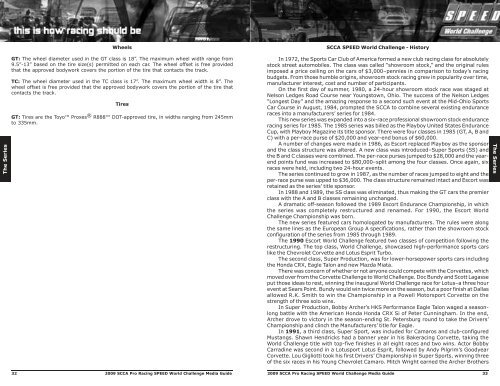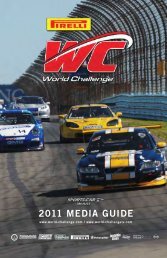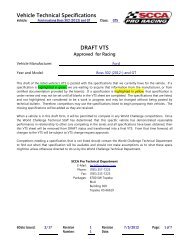built to conquer the greatest battle of all. your ... - World Challenge
built to conquer the greatest battle of all. your ... - World Challenge
built to conquer the greatest battle of all. your ... - World Challenge
Create successful ePaper yourself
Turn your PDF publications into a flip-book with our unique Google optimized e-Paper software.
The Series<br />
Wheels<br />
GT: The wheel diameter used in <strong>the</strong> GT class is 18”. The maximum wheel width range from<br />
9.5”-13” based on <strong>the</strong> tire size(s) permitted on each car. The wheel <strong>of</strong>fset is free provided<br />
that <strong>the</strong> approved bodywork covers <strong>the</strong> portion <strong>of</strong> <strong>the</strong> tire that contacts <strong>the</strong> track.<br />
TC: The wheel diameter used in <strong>the</strong> TC class is 17”. The maximum wheel width is 8”. The<br />
wheel <strong>of</strong>fset is free provided that <strong>the</strong> approved bodywork covers <strong>the</strong> portion <strong>of</strong> <strong>the</strong> tire that<br />
contacts <strong>the</strong> track.<br />
Tires<br />
GT: Tires are <strong>the</strong> Toyo Proxes ® R888 DOT-approved tire, in widths ranging from 245mm<br />
<strong>to</strong> 335mm.<br />
32 2009 SCCA Pro Racing SPEED <strong>World</strong> Ch<strong>all</strong>enge Media Guide<br />
SCCA SPEED <strong>World</strong> Ch<strong>all</strong>enge - His<strong>to</strong>ry<br />
In 1972, <strong>the</strong> Sports Car Club <strong>of</strong> America formed a new club racing class for absolutely<br />
s<strong>to</strong>ck street au<strong>to</strong>mobiles. The class was c<strong>all</strong>ed “showroom s<strong>to</strong>ck,” and <strong>the</strong> original rules<br />
imposed a price ceiling on <strong>the</strong> cars <strong>of</strong> $3,000–pennies in comparison <strong>to</strong> <strong>to</strong>day’s racing<br />
budgets. From those humble origins, showroom s<strong>to</strong>ck racing grew in popularity over time,<br />
manufacturer interest, cost and number <strong>of</strong> participants.<br />
On <strong>the</strong> first day <strong>of</strong> summer, 1980, a 24-hour showroom s<strong>to</strong>ck race was staged at<br />
Nelson Ledges Road Course near Youngs<strong>to</strong>wn, Ohio. The success <strong>of</strong> <strong>the</strong> Nelson Ledges<br />
“Longest Day” and <strong>the</strong> amazing response <strong>to</strong> a second such event at <strong>the</strong> Mid-Ohio Sports<br />
Car Course in August, 1984, prompted <strong>the</strong> SCCA <strong>to</strong> combine several existing endurance<br />
races in<strong>to</strong> a manufacturers’ series for 1984.<br />
This new series was expanded in<strong>to</strong> a six-race pr<strong>of</strong>essional showroom s<strong>to</strong>ck endurance<br />
racing series for 1985. The 1985 series was billed as <strong>the</strong> Playboy United States Endurance<br />
Cup, with Playboy Magazine its title sponsor. There were four classes in 1985 (GT, A, B and<br />
C) with a per-race purse <strong>of</strong> $20,000 and year-end bonus <strong>of</strong> $60,000.<br />
A number <strong>of</strong> changes were made in 1986, as Escort replaced Playboy as <strong>the</strong> sponsor<br />
and <strong>the</strong> class structure was altered. A new class was introduced–Super Sports (SS) and<br />
<strong>the</strong> B and C classes were combined. The per-race purses jumped <strong>to</strong> $28,000 and <strong>the</strong> yearend<br />
points fund was increased <strong>to</strong> $80,000–split among <strong>the</strong> four classes. Once again, six<br />
races were held, including two 24-hour events.<br />
The series continued <strong>to</strong> grow in 1987, as <strong>the</strong> number <strong>of</strong> races jumped <strong>to</strong> eight and <strong>the</strong><br />
per-race purse was upped <strong>to</strong> $36,000. The class structure remained intact and Escort was<br />
retained as <strong>the</strong> series’ title sponsor.<br />
In 1988 and 1989, <strong>the</strong> SS class was eliminated, thus making <strong>the</strong> GT cars <strong>the</strong> premier<br />
class with <strong>the</strong> A and B classes remaining unchanged.<br />
A dramatic <strong>of</strong>f-season followed <strong>the</strong> 1989 Escort Endurance Championship, in which<br />
<strong>the</strong> series was completely restructured and renamed. For 1990, <strong>the</strong> Escort <strong>World</strong><br />
Ch<strong>all</strong>enge Championship was born.<br />
The new series featured cars homologated by manufacturers. The rules were along<br />
<strong>the</strong> same lines as <strong>the</strong> European Group A specifications, ra<strong>the</strong>r than <strong>the</strong> showroom s<strong>to</strong>ck<br />
configuration <strong>of</strong> <strong>the</strong> series from 1985 through 1989.<br />
The 1990 Escort <strong>World</strong> Ch<strong>all</strong>enge featured two classes <strong>of</strong> competition following <strong>the</strong><br />
restructuring. The <strong>to</strong>p class, <strong>World</strong> Ch<strong>all</strong>enge, showcased high-performance sports cars<br />
like <strong>the</strong> Chevrolet Corvette and Lotus Esprit Turbo.<br />
The second class, Super Production, was for lower-horsepower sports cars including<br />
<strong>the</strong> Honda CRX, Eagle Talon and new Mazda Miata.<br />
There was concern <strong>of</strong> whe<strong>the</strong>r or not anyone could compete with <strong>the</strong> Corvettes, which<br />
moved over from <strong>the</strong> Corvette Ch<strong>all</strong>enge <strong>to</strong> <strong>World</strong> Ch<strong>all</strong>enge. Doc Bundy and Scott Lagasse<br />
put those ideas <strong>to</strong> rest, winning <strong>the</strong> inaugural <strong>World</strong> Ch<strong>all</strong>enge race for Lotus–a three hour<br />
event at Sears Point. Bundy would win twice more on <strong>the</strong> season, but a poor finish at D<strong>all</strong>as<br />
<strong>all</strong>owed R.K. Smith <strong>to</strong> win <strong>the</strong> Championship in a Powell Mo<strong>to</strong>rsport Corvette on <strong>the</strong><br />
strength <strong>of</strong> three solo wins.<br />
In Super Production, Bobby Archer’s HKS Performance Eagle Talon waged a seasonlong<br />
<strong>battle</strong> with <strong>the</strong> American Honda Honda CRX Si <strong>of</strong> Peter Cunningham. In <strong>the</strong> end,<br />
Archer drove <strong>to</strong> vic<strong>to</strong>ry in <strong>the</strong> season-ending St. Petersburg round <strong>to</strong> take <strong>the</strong> Drivers’<br />
Championship and clinch <strong>the</strong> Manufacturers’ title for Eagle.<br />
In 1991, a third class, Super Sport, was included for Camaros and club-configured<br />
Mustangs. Shawn Hendricks had a banner year in his Bakeracing Corvette, taking <strong>the</strong><br />
<strong>World</strong> Ch<strong>all</strong>enge title with <strong>to</strong>p-five finishes in <strong>all</strong> eight races and two wins. Ac<strong>to</strong>r Bobby<br />
Carradine was second in a Lotusport Lotus Esprit, followed by Andy Pilgrim’s Goodyear<br />
Corvette. Lou Gigliotti <strong>to</strong>ok his first Drivers’ Championship in Super Sports, winning three<br />
<strong>of</strong> <strong>the</strong> six races in his Young Chevrolet Camaro. Mitch Wright earned <strong>the</strong> Archer Bro<strong>the</strong>rs<br />
2009 SCCA Pro Racing SPEED <strong>World</strong> Ch<strong>all</strong>enge Media Guide 33<br />
The Series




